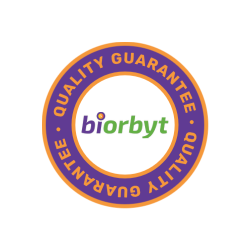You have no items in your shopping cart.
Hsp60/HSPD1 Antibody (monoclonal, 6G2)
Catalog Number: orb570314
| Catalog Number | orb570314 |
|---|---|
| Category | Antibodies |
| Description | Hsp60/HSPD1 Antibody (monoclonal, 6G2) |
| Species/Host | Mouse |
| Clonality | Monoclonal |
| Clone Number | 6G2 |
| Tested applications | FC, ICC, IF, IHC, WB |
| Reactivity | Human, Mouse, Rat |
| Isotype | Mouse IgG1 |
| Immunogen | E.coli-derived human Hsp60/HSPD1 recombinant protein (Position: A260-Q496). Human Hsp60 shares 97% amino acid (aa) sequence identity with both mouse and rat Hsp60. |
| Concentration | 0 |
| Form/Appearance | Lyophilized |
| Conjugation | Unconjugated |
| MW | 60 kDa |
| UniProt ID | P10809 |
| Sensitivity | < 10pg/ml |
| Storage | Store at -20˚C for one year from date of receipt. After reconstitution, at 4˚C for one month. It can also be aliquotted and stored frozen at -20˚C for six months. Avoid repeated freeze-thaw cycles. |
| Alternative names | 60 kDa heat shock protein, mitochondrial; 60 kDa c Read more... |
| Note | For research use only |
| Application notes | Tested Species: In-house tested species with positive results. By Heat: Boiling the paraffin sections in 10mM citrate buffer, pH6.0, for 20mins is required for the staining of formalin/paraffin sections. Other applications have not been tested. Optimal dilutions should be determined by end users. Add 0.2ml of distilled water will yield a concentration of 500μg/ml. |
| Expiration Date | 12 months from date of receipt. |
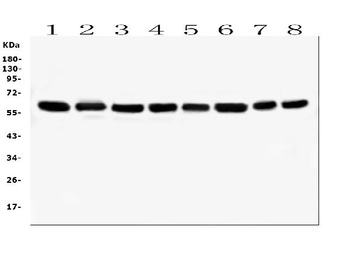
Western blot analysis of HSPD1 using anti-HSPD1 antibody (orb570314). Electrophoresis was performed on a 5-20% SDS-PAGE gel at 70V (Stacking gel)/90V (Resolving gel) for 2-3 hours. The sample well of each lane was loaded with 50ug of sample under reducing conditions. Lane 1: human Caco-2 whole cell lysates Lane 2: human A549 whole cell lysates Lane 3: human THP-1 whole cell lysates Lane 4: human SW620 whole cell lysates Lane 5: human U-937 whole cell lysates Lane 6: human HepG2 whole cell lysates Lane 7: rat RH35 whole cell lysates Lane 8: mouse RAW246.7 whole cell lysates. After Electrophoresis, proteins were transferred to a Nitrocellulose membrane at 150mA for 50-90 minutes. Blocked the membrane with 5% Non-fat Milk/TBS for 1.5 hour at RT. The membrane was incubated with mouse anti-HSPD1 antigen affinity purified monoclonal antibody (Catalog # orb570314) at 0.5 μg/mL overnight at 4°C, then washed with TBS-0.1%Tween 3 times with 5 minutes each and probed with a goat anti-mouse IgG-HRP secondary antibody at a dilution of 1:10000 for 1.5 hour at RT. The signal is developed using an Enhanced Chemiluminescent detection (ECL) kit (Catalog # orb90502) with Tanon 5200 system. A specific band was detected for HSPD1 at approximately 60KD. The expected band size for HSPD1 is at 60KD.
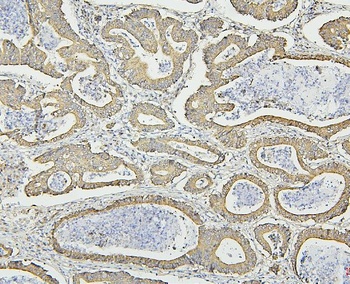
IHC analysis of HSPD1 using anti-HSPD1 antibody (orb570314). HSPD1 was detected in paraffin-embedded section of human intestinal cancer tissues. Heat mediated antigen retrieval was performed in citrate buffer (pH6, epitope retrieval solution) for 20 mins. The tissue section was blocked with 10% goat serum. The tissue section was then incubated with 1μg/ml mouse anti-HSPD1 Antibody (orb570314) overnight at 4°C. Biotinylated goat anti-mouse IgG was used as secondary antibody and incubated for 30 minutes at 37°C. The tissue section was developed using Strepavidin-Biotin-Complex (SABC) (Catalog # orb90443) with DAB as the chromogen.
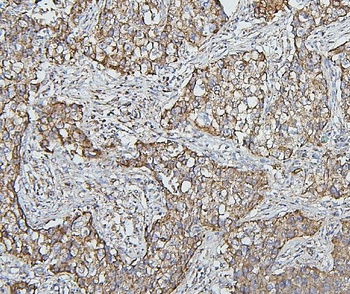
IHC analysis of HSPD1 using anti-HSPD1 antibody (orb570314). HSPD1 was detected in paraffin-embedded section of human lung cancer tissues. Heat mediated antigen retrieval was performed in citrate buffer (pH6, epitope retrieval solution) for 20 mins. The tissue section was blocked with 10% goat serum. The tissue section was then incubated with 1μg/ml mouse anti-HSPD1 Antibody (orb570314) overnight at 4°C. Biotinylated goat anti-mouse IgG was used as secondary antibody and incubated for 30 minutes at 37°C. The tissue section was developed using Strepavidin-Biotin-Complex (SABC) (Catalog # orb90443) with DAB as the chromogen.
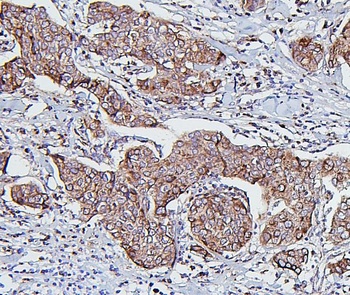
IHC analysis of HSPD1 using anti-HSPD1 antibody (orb570314). HSPD1 was detected in paraffin-embedded section of human mammary cancer tissues. Heat mediated antigen retrieval was performed in citrate buffer (pH6, epitope retrieval solution) for 20 mins. The tissue section was blocked with 10% goat serum. The tissue section was then incubated with 1μg/ml mouse anti-HSPD1 Antibody (orb570314) overnight at 4°C. Biotinylated goat anti-mouse IgG was used as secondary antibody and incubated for 30 minutes at 37°C. The tissue section was developed using Strepavidin-Biotin-Complex (SABC) (Catalog # orb90443) with DAB as the chromogen.
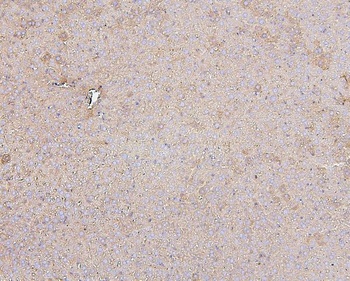
IHC analysis of HSPD1 using anti-HSPD1 antibody (orb570314). HSPD1 was detected in paraffin-embedded section of mouse liver tissues. Heat mediated antigen retrieval was performed in citrate buffer (pH6, epitope retrieval solution) for 20 mins. The tissue section was blocked with 10% goat serum. The tissue section was then incubated with 1μg/ml mouse anti-HSPD1 Antibody (orb570314) overnight at 4°C. Biotinylated goat anti-mouse IgG was used as secondary antibody and incubated for 30 minutes at 37°C. The tissue section was developed using Strepavidin-Biotin-Complex (SABC) (Catalog # orb90443) with DAB as the chromogen.
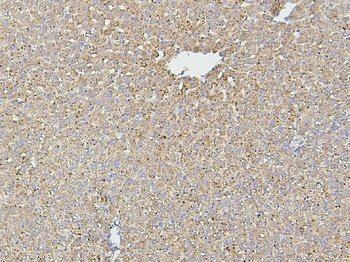
IHC analysis of HSPD1 using anti-HSPD1 antibody (orb570314). HSPD1 was detected in paraffin-embedded section of rat liver tissues. Heat mediated antigen retrieval was performed in citrate buffer (pH6, epitope retrieval solution) for 20 mins. The tissue section was blocked with 10% goat serum. The tissue section was then incubated with 1μg/ml mouse anti-HSPD1 Antibody (orb570314) overnight at 4°C. Biotinylated goat anti-mouse IgG was used as secondary antibody and incubated for 30 minutes at 37°C. The tissue section was developed using Strepavidin-Biotin-Complex (SABC) (Catalog # orb90443) with DAB as the chromogen.
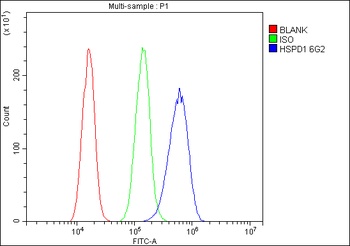
Flow Cytometry analysis of A431 cells using anti-HSPD1 antibody (orb570314). Overlay histogram showing A431 cells stained with orb570314 (Blue line). The cells were blocked with 10% normal goat serum. And then incubated with mouse anti-HSPD1 Antibody (orb570314, 1μg/1x10^6 cells) for 30 min at 20°C. DyLight®488 conjugated goat anti-mouse IgG (5-10μg/1x10^6 cells) was used as secondary antibody for 30 minutes at 20°C. Isotype control antibody (Green line) was mouse IgG (1μg/1x10^6) used under the same conditions. Unlabelled sample (Red line) was also used as a control.
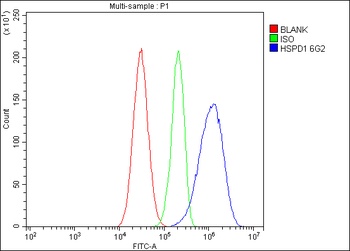
Flow Cytometry analysis of HepG2 cells using anti-HSPD1 antibody (orb570314). Overlay histogram showing HepG2 cells stained with orb570314 (Blue line). The cells were blocked with 10% normal goat serum. And then incubated with mouse anti-HSPD1 Antibody (orb570314, 1μg/1x10^6 cells) for 30 min at 20°C. DyLight®488 conjugated goat anti-mouse IgG (5-10μg/1x10^6 cells) was used as secondary antibody for 30 minutes at 20°C. Isotype control antibody (Green line) was mouse IgG (1μg/1x10^6) used under the same conditions. Unlabelled sample (Red line) was also used as a control.
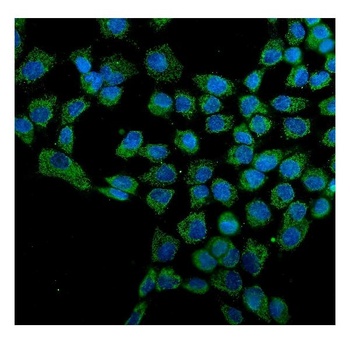
IF analysis of Hsp60/HSPD1 using anti-Hsp60/HSPD1 antibody (orb570314). Hsp60/HSPD1 was detected in immunocytochemical section of A431 cells. Enzyme antigen retrieval was performed using IHC enzyme antigen retrieval reagent (orb90553) for 15 mins. The cells were blocked with 10% goat serum. And then incubated with 5μg/mL mouse anti-Hsp60/HSPD1 Antibody (orb570314) overnight at 4°C. DyLight®488 Conjugated Goat Anti-Mouse IgG was used as secondary antibody at 1:100 dilution and incubated for 30 minutes at 37°C. The section was counterstained with DAPI. Visualize using a fluorescence microscope and filter sets appropriate for the label used.
Anti-Hsp60/HSPD1 Antibody (monoclonal, 6G2) (APC) [orb2609048]
FC, ICC, IF, IHC, WB
Human, Mouse, Rat
Mouse
Monoclonal
APC
100 μgAnti-Hsp60/HSPD1 Antibody (monoclonal, 6G2) (HRP) [orb2609049]
FC, ICC, IF, IHC, WB
Human, Mouse, Rat
Mouse
Monoclonal
HRP
100 μgAnti-Hsp60/HSPD1 Antibody (monoclonal, 6G2) (FITC) [orb2609050]
FC, ICC, IF, IHC, WB
Human, Mouse, Rat
Mouse
Monoclonal
FITC
100 μgAnti-Hsp60/HSPD1 Antibody (monoclonal, 6G2) (Cy3) [orb2609051]
FC, ICC, IF, IHC, WB
Human, Mouse, Rat
Mouse
Monoclonal
Cy3
100 μgAnti-Hsp60/HSPD1 Antibody (monoclonal, 6G2) (Biotin) [orb2609052]
FC, ICC, IF, IHC, WB
Human, Mouse, Rat
Mouse
Monoclonal
Biotin
100 μg
Filter by Rating
- 5 stars
- 4 stars
- 3 stars
- 2 stars
- 1 stars


